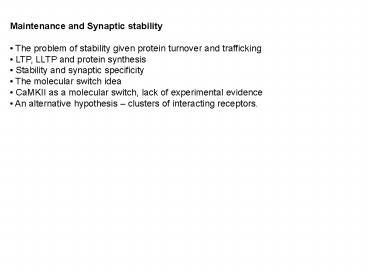Maintenance and Synaptic stability - PowerPoint PPT Presentation
1 / 11
Title:
Maintenance and Synaptic stability
Description:
... can be expressed by protein number or state. ... solution, a molecular switch (Crick, ... how can it effect different synapses differently in order to ... – PowerPoint PPT presentation
Number of Views:30
Avg rating:3.0/5.0
Title: Maintenance and Synaptic stability
1
- Maintenance and Synaptic stability
- The problem of stability given protein turnover
and trafficking - LTP, LLTP and protein synthesis
- Stability and synaptic specificity
- The molecular switch idea
- CaMKII as a molecular switch, lack of
experimental evidence - An alternative hypothesis clusters of
interacting receptors.
2
Stable, synapse specific, synaptic plasticity
how can this be accomplished?
Synaptic strengths can be expressed by protein
number or state. For example number of AMPA
receptors, or the phosphorylation state of AMPA
receptors.
However, such proteins and their specific
conformational states have limited life times,
much shorter than the life time of memories, or
even of long term synaptic plasticity.
One proposed solution, a molecular switch
(Crick, Lisman)
3
- The calcium signal that leads to LTP is short, on
the order of seconds, yet plasticity lasts a
lifetime. - Phsphorylation
- Dephosphorylation What is phopsphorylated by
Kinases, it typically dephosphorylated by
phosphatases. - Protein turnover Proteins have a limited
lifetime (hours, possibly days), when a
phosphorylated protein is elimiated and a new one
generated, the new one will not be phosphorylated - Diffusion and trafficking When proteins are
phosphorylated in one synapse, they are likely to
diffuse away, or be actively trafficked away.
4
- Insertion of synapses
- Trafficking receptors are rapidly trafficked
into and away from spines. If the number is
increased due to plasticity, it may
re-equilibrate due to trafficking, diffusion and
turnover.
5
The most studied example auto-phosphorylation in
CaMKII holoenzymes.
- Problems
- Molecular switches are bi-stable (binary)
p
p
p
- No solid experimental evidence
6
The concept of bi-stability
CaMKIIp
Ca
7
But actually (Bradshaw et al. 2003)
Maybe it is bi-stable is cells
8
So what could the stability mechanism be?
9
Explain on board about L-LTP induction
10
Fonseca et. al. 2006
11
Late phase of LTP, LLTP is protein synthesis
dependent. If we can turn on protein synthesis,
we can make more of a given protein (say AMPA
receptors), more or less permanently, overcoming
the problem of turnover However Protein
synthesis is a whole cell processes, how can it
effect different synapses differently in order to
preserve synapse specificity. The synaptic tag
hypothesis.































